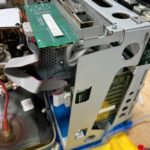The PCJr
A slight diversion this evening…..the powerhouse that is the PCJr.
The PCJr was an eventual failure in the market, with around 400,000 total produced. Interestingly enough Tandy even made a PCJr semi-clone called the Tandy 1000.
The power supply was bad, but I had a spare so I was able to get that working. At first the keyboard wasn’t working, which is a somewhat common problem with these PCJrs. There is a capacitor in the keyboard that eventually starts shorting, so a replacement fixed that.
I have a cartridge that goes in the cartridge port that maps an SD card as a hard drive, which makes it much easier to move things around.
Once I get it formatted, I’ll get Kings Quest running.


















































